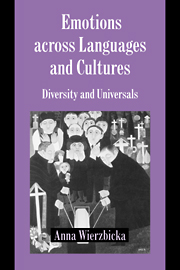Book contents
- Frontmatter
- Contents
- List of figures
- Acknowledgments
- List of abbreviations
- 1 Introduction: feelings, languages, and cultures
- 2 Defining emotion concepts: discovering “cognitive scenarios”
- 3 A case study of emotion in culture: German Angst
- 4 Reading human faces
- 5 Russian emotional expression
- 6 Comparing emotional norms across languages and cultures: Polish vs. Anglo-American
- 7 Emotional universals
- Notes
- References
- Index
1 - Introduction: feelings, languages, and cultures
Published online by Cambridge University Press: 22 August 2009
- Frontmatter
- Contents
- List of figures
- Acknowledgments
- List of abbreviations
- 1 Introduction: feelings, languages, and cultures
- 2 Defining emotion concepts: discovering “cognitive scenarios”
- 3 A case study of emotion in culture: German Angst
- 4 Reading human faces
- 5 Russian emotional expression
- 6 Comparing emotional norms across languages and cultures: Polish vs. Anglo-American
- 7 Emotional universals
- Notes
- References
- Index
Summary
Emotions or feelings?
According to the biologist Charles Birch (1995: ix), “Feelings are what matter most in life”. While it is debatable whether they really matter “most”, they certainly matter a great deal; and it is good to see that after a long period of scholarly neglect, feelings are now at the forefront of interdisciplinary investigations, spanning the humanities, social sciences, and biological sciences.
Some would say: not “feelings”, but “emotions” – and the question “which of the two (feelings or emotions)?” plunges us straight into the heart of the central controversy concerning the relationship between human biology on the one hand and language and culture on the other.
Many psychologists appear to be more comfortable with the term “emotion” than “feeling” because “emotions” seem to be somehow “objective”. It is often assumed that only the “objective” is real and amenable to rigorous study, and that “emotions” have a biological foundation and can therefore be studied “objectively”, whereas feelings cannot be studied at all. (Birch (1995: v) calls this attitude “the flight from subjectivity”; see also Gaylin 1979).
Seventy years ago the founder of behaviourism John Watson proposed the following definition (quoted in Plutchik 1994: 3): “An emotion is an hereditary ‘pattern-reaction’ involving profound changes of the bodily mechanisms as a whole, but particularly of the visceral and glandular systems”. While such purely behaviouristic conceptions of “emotions” have now been repudiated, “emotions” are still often seen as something that, for example, can be measured.
- Type
- Chapter
- Information
- Emotions across Languages and CulturesDiversity and Universals, pp. 1 - 48Publisher: Cambridge University PressPrint publication year: 1999



